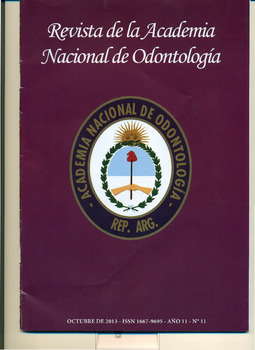Citología bucal: método auxiliar del diagnóstico clínico en diabéticos tipo II
Oral cytology: an auxiliary method for clinical diagnosis in type II diabetics.
| dc.contributor.author | Gomez de Ferraris, María Elsa | |
| dc.contributor.author | Rodriguez, Ismael | |
| dc.contributor.author | Flores,Viviana | |
| dc.contributor.author | Grunberg, Karina | |
| dc.date.accessioned | 2019-10-29T16:05:49Z | |
| dc.date.available | 2019-10-29T16:05:49Z | |
| dc.date.issued | 2013 | |
| dc.identifier.issn | 1667-9695 | |
| dc.identifier.uri | http://hdl.handle.net/11086/13481 | |
| dc.description.abstract | El objetivo de este trabajo fue evaluar los cambios estructurales y morfométricos de las células epiteliales de la mucosa bucal de pacientes diabéticos tipo II, utilizando como método auxiliar diagnóstico la citología exfoliativa.Se tomaron muestras de la zona yugal y de la porción lingual en diez pacientes diabéticos tipo II y seis sin estos antecedentes como controles. Los extendidos se obtuvieron mediante ?citobrush? y se colorearon con la técnica de Papanicolaou. El índice eosinófilo (IE), se calculó sobre lavase de cien células de cinco campos elegidos al azar en cada muestra y en ambas zonas. Para el análisis morfométrico, se estimaron treinta células por preparado se midió con el programa Image Pro-Plus 4.5. Se calculó área citoplasmática, área nuclear y relación núcleo/citoplasma (RNC). El índice eosinófilo fue significativamente menor en diabéticos respecto al control. Los pacientes diabéticos mostraron valores promedio de RNC significativamente mayor y el área nuclear fue mayor en las células con menor tamaño. Conclusiones: los cambios estructurales y morfométricos podrían atribuirse a la hiposalivación provocada por la diabetes tipo II. Se destaca la utilidad de la citología exfoliativa como técnica complementaria al diagnóstico clínico. | es |
| dc.description.abstract | The aim of this study was to evaluate the structural and morphometric changes of the epithelial cells of the buccal mucosa of type II diabetic patients, using exfoliative cytology as an auxiliary diagnostic method. Samples were taken from the jugal area and from the lingual portion in ten type II diabetic patients and six patients without these antecedents as controls. The smears were obtained by cytobrush and stained with the Papanicolaou technique. The eosinophil index (EI) was calculated on a wash of 100 cells from five randomly selected fields in each sample and in both areas. For morphometric analysis, thirty cells per preparation were estimated and measured with Image Pro-Plus 4.5 software. Cytoplasmic area, nuclear area and nucleus/cytoplasm ratio (CNR) were calculated. The eosinophil index was significantly lower in diabetics than in controls. Diabetic patients showed significantly higher average CNR values and nuclear area was higher in cells with smaller size. Conclusions: structural and morphometric changes could be attributed to hyposalivation caused by type II diabetes. The usefulness of exfoliative cytology as a complementary technique to clinical diagnosis is highlighted. | |
| dc.format.medium | Impreso | |
| dc.language.iso | spa | es |
| dc.rights | Attribution-NonCommercial-ShareAlike 4.0 International | * |
| dc.rights.uri | https://creativecommons.org/licenses/by-nc-sa/4.0/ | * |
| dc.subject | Morfologia | |
| dc.subject | Morfometria | |
| dc.subject | Diabetes tipo II | |
| dc.title | Citología bucal: método auxiliar del diagnóstico clínico en diabéticos tipo II | es |
| dc.title | Oral cytology: an auxiliary method for clinical diagnosis in type II diabetics. | |
| dc.type | article | es |
| dc.description.version | publishedVersion | |
| dc.description.fil | Fil: Gómez de Ferraris, María Elsa. Universidad Nacional de Córdoba. Facultad de Odontología; Argentina. | |
| dc.description.fil | Fil: Grunberg, Karina. Universidad Nacional de Córdoba. Facultad de Ciencias Exactas, Físicas y Naturales; Escuela de Biología; Argentina. | |
| dc.journal.city | Buenos Aires | |
| dc.journal.country | Argentina | |
| dc.journal.pagination | 44-49 | |
| dc.journal.referato | Con referato | |
| dc.journal.title | Revista Academia Nacional de Odontología | |
| dc.journal.tome | 1 | |
| dc.journal.volume | 11 | |
| dc.description.field | Otras Ciencias de la Salud |





